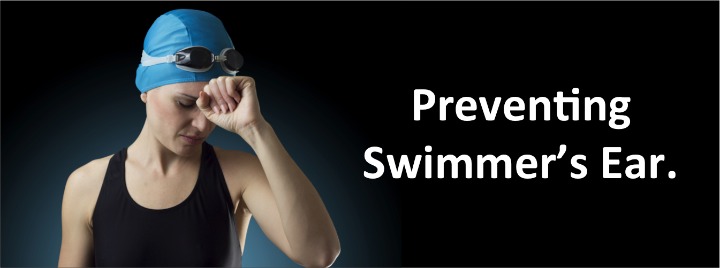Are you planning a holiday trip? Here's some advice from one of our consulting ENT specialists, Dr Peter Desmarais!
All people need some protection from the effects of water in the ear. Any other mammal that spends time in water with any regularity has “built in protection”. The whale has a permanent plug and animals like seals, badgers, polar bears etc, close off their ear canal using little muscles around the ear.
However, water will always enter our ears when we go into water. Swimmers, divers and others who spend more time in water, very often develop a disorder commonly known as Swimmer’s Ear. Some individuals can allow water to enter their ear with impunity, whist others develop problems after only a short time in water.
The concept of protecting the ear canal BEFORE allowing water to enter it is a paradigm shift in the approach to this problem. Such protection needs to mimic the natural protection of the ear (such as that afforded by wax). A proprietary eardrop formulated from silicone oil (SwimSeal) is an example of such a preparation. It can be used before entering water, obviating the need to plug the ear and it facilitates the egress of water on exiting the water.
SWIMMER'S EAR EXPLAINED
This so-called “swimmer's ear” is not necessarily synonymous with the disorder that doctors in clinical practice diagnose as otitis externa.
Whilst swimmer's ear is a form of Otitis externa, but classical otitis externa is not necessarily swimmer's ear, and can occur unrelated to swimming, such as in persons who probe their ears, diabetics etc.
When a swimmer develops a “water-related inflammation” of his ear canal, he will invariably be diagnosed and treated by his doctor or ENT as an inflammatory infection of the canal- regardless of the cause. In most cases a bacterial or fungal infection will not be demonstrated, but such treatment will in most cases resolve the problem until the next event.
The human ear canal (external auditory canal) is a skin lined canal - a most unusual arrangement for any “canal” entering the body. Nowhere else in the human body is there an orifice or canal that is lined with skin (the umbilicus-or belly button is an exception, but being only a few mm deep, it hardly qualifies as a canal). Any other orifice is lined with a “wet” mucous membrane.
Since human skin cannot tolerate being exposed to water for any length of time without becoming macerated (soften and weaken), the ear canal, which cannot easily dry out, requires special protection. The fact that the skin lining the ear canal does not desquamate (come off in scales or flakes, like all other skin), together with the presence of wax, affords a large degree of protection to this area. The skin here migrates outwards and the presence of wax prevents premature desquamation (by literally keeping any skin with a tendency to desquamate adherent to the sides).
So, whilst most of one’s skin easily dries out after being immersed in water, the ear canal does not have this luxury (it is after all a 3.5 cm dark, damp channel entering the skull).
A body of water that is polluted can be more problematic but there is no easy way to establish the degree of pollution. Common sense dictates that water that is dirty is more likely to transmit pathogenic microorganisms to an ear that has become irritated by water. In such a case, one could develop an inflamed ear canal (swimmer's ear) which then becomes infected (bacterial or fungal Otitis externa).
The approach to preventing “water-related ear canal inflammation” with or without infection requires a major paradigm shift.
The conventional medical wisdom (handed down from medical textbook to medical textbook and from lecturer to students throughout the ages), is to dry out the ear canal after the ingress of water. This is sound advice, but here’s the thing: the ear should not be dried by probing with buds etc and CERTAINLY NOT with an eardrop that contains alcohol.
It is simple logic that alcohol, whilst it might effectively dry the canal almost instantly, will do this at the expense of the protective elements of the ear canal especially by removing the thin layer of wax.
Using a form of protection that mimics the normal body protection is physiologically correct and basically common sense. Ear plugs are uncomfortable, take the fun out of swimming and seldom effectively occlude the ear.
MY ADVICE TO HOLIDAY MAKERS:
- Protect the ear canal with a few drops of SwimSeal into each ear prior to entering water (At present, SwimSeal is the only such preparation available). It is virtually an “invisible earplug”.
- If one cannot obtain SwimSeal, then consider using well designed and well fitting earplugs. An audiologist can even make custom plugs.
- Always dry the ear well after exiting water, by holding a paper tissue over the opening and shaking vigorously-but don’t insert it into the canal. Even jumping on one leg with the head tilted to that side can help.
- Consider using a hairdryer on low heat to gently blow air into the ear canal-but don’t do it for longer than a few seconds, and try to do both canals almost simultaneously (well a few seconds apart!)-otherwise one could get dizzy (so-called caloric effect).
- Don’t go into polluted and dirty water, and if you do, then the first two measures apply even more.
- Always consult a doctor if you develop a persistently painful ear after swimming.
- Children with grommets (ear tubes) will need to use earplugs or better still, abstain from swimming.

